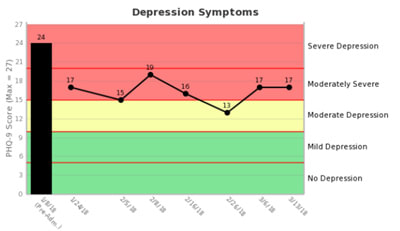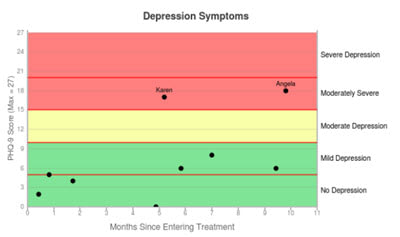Dr. Ingrid Carlier published a meta-analysis in 2012 that showed that providing clinicians with patient-reported data helped patients get better faster in three addiction treatment clinical trials. Whereas it is often estimated to take 17 years for scientific research to reach clinical practice, leading addiction treatment centers are now speeding up this process, especially with the Joint Commission’s push to use data for improving treatment effectiveness.
But what does it take to actually become a data-driven treatment center? Here are nine steps to make data a central part of your treatment strategy, enhancing patient care and ensuring measurable progress.
9 Steps to Becoming a Data-Driven Addiction Treatment Center
Step 1: Embrace the Benefits of Data in Treatment
The first step in becoming a data-driven center is recognizing how data improves treatment outcomes. Research has shown that when clinicians have access to patient-reported data, patients recover faster. Data helps pinpoint when someone is struggling and where treatment can be fine-tuned to meet their needs. Starting with this foundation keeps the focus on making informed, real-time adjustments that keep patients on track, which leads to better, faster outcomes.
Step 2: Implement Real-Time Progress Monitoring
Investing in real-time progress monitoring, such as INSIGHT Addiction’s software, gives clinicians continuous access to each patient’s journey in treatment. Real-time data helps clinicians avoid relying solely on subjective impressions or estimations, which often lean toward optimism. Instead, they’re armed with clear, graphical evidence of each patient’s status, allowing them to see instantly if someone is stagnating or ready for the next step.
Step 3: Introduce Pre-Session Check-Ins
Adding quick pre-session check-ins creates a regular flow of information that clinicians can use to prepare for each session. With real-time updates on how a patient is feeling and any current concerns, clinicians can make every session count. This step is particularly valuable because it gives patients a direct voice in their treatment and helps them feel heard and engaged, which increases buy-in and leads to better outcomes.
Step 4: Use Data to Inform Session Planning and Adjustments
 |
Data isn’t just for tracking; it should actively inform every step of treatment. When administrators and clinicians look at progress monitoring data regularly, it’s easier to spot if a patient is struggling or hitting a plateau, and make adjustments before things spiral, allowing them to increase the intensity of sessions, add additional support, or try new techniques to keep treatment effective and responsive to each patient’s needs.
Step 5: Establish Open Communication Channels Using Data
 |
Data also adds an extra layer of communication between patients, clinicians, and management, which helps keep everyone aligned. Tools like group summary reports offer management a high-level view of patient outcomes and progress, which means they can spot any trends and step in early if necessary. This birds-eye perspective allows managers to take action as soon as issues arise, ensuring patients don’t slip through the cracks. Plus, patients feel like the whole team is invested in their success when they see how closely their progress is being monitored.
Step 6: Aggregate Data to Benchmark and Identify Trends
Beyond individual tracking, aggregating data across patients reveals larger trends and benchmarks for comparison. With aggregated data, centers can see where they’re excelling and where improvements are needed. Comparing results to industry norms allows treatment centers to highlight areas where they outperform others and set focused improvement goals in areas where progress is still needed. This level of insight makes it easier to allocate resources effectively and demonstrate the center’s strengths to patients, families, and stakeholders.
Step 7: Set Data-Driven Goals for Improvement
Using data to guide improvement goals ensures that every effort has a measurable impact. Centers can set clear, quantifiable goals, like improving patient satisfaction or reducing the severity of specific co-occurring disorders. Tracking these goals over time allows teams to measure the direct effect of changes in their approach, making it easier to refine processes in real-time.
Step 8: Identify Patients at Risk of Leaving Against Medical Advice (AMA)
One of the most valuable uses of data is in predicting who may be at risk of leaving against medical advice (AMA). With software like Vista’s, centers can identify patients at high risk of leaving and intervene before they make the decision to leave. By tracking engagement, mood, and progress, Vista’s research-backed system can pinpoint almost 80% of patients at risk of leaving AMA. This proactive approach means that clinicians and staff can offer extra support at the right time, boosting retention and helping more patients see their treatment through to the end.
Step 9: Cultivate a Data-Driven Culture in Your Center
Becoming data-driven goes beyond just using software—it’s about creating a culture that values data in every decision. To make data central to your approach, build a routine of regular data reviews, discuss outcomes with your team, and make data part of the conversation in team meetings. A data-driven culture keeps everyone on the same page, ensuring that each staff member understands the importance of using data to drive treatment improvements.
If you are interested in learning more about becoming a data-driven center, please reach out to one of our research specialists (800) 215-3201 ext 1. Thank you for all the hard work you and your team do to help patients recover from addiction!




